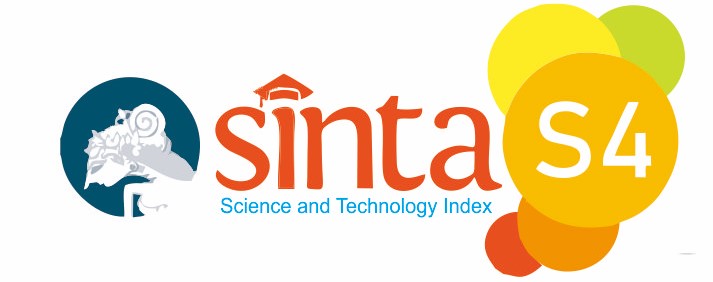PENERAPAN VIRTUAL LABORATORY DENGAN MENGGUNAKAN MODEL PROBLEM BASED LEARNING (PBL) UNTUK MENDUKUNG PROSES PEMBELAJARAN KIMIA
Abstract
The implementation of Virtual Laboratory in learning is a 21st century media that is expected to be able to help students master abstract and arithmetic chemistry material. Supported by the PBL learning model, this media is expected to be able to develop students' skills to become independent learners through solving the problems given, so that it is expected to improve student learning outcomes. The research was conducted using a quasi-experimental design with a pretest and posttest design, in order to determine the effect of applying the PBL learning model using virtual laboratory media on students' chemistry learning outcomes. The test instrument supported by observation was analyzed for differences in effect using the t-test. The results showed the significant difference in student learning outcomes, at a significant level of 5% which indicated the influence of virtual laboratory media on the application of the PBL learning model on students' chemistry learning outcomes in the matter of reaction rates, with an effect coefficient of 7.8%.
Keywords : Problem Based Learning, Virtual Chemistry Laboratory, Reaction Rate
Full Text:
PDFReferences
Ambusaidi, A., Al Musawi, A., Al-Balushi, S., & Al-Balushi, K. (2018). The Impact Of Virtual Lab Learning Experiences On 9th Grade Students’ Achievement And Their Attitudes Towards Science And Learning By Virtual Lab. Journal of Turkish Science Education, 15(2), 13-29.
Antara, I. P. P. A. (2022). Model Pembelajaran Problem Based Learning Untuk Meningkatkan Hasil Belajar Kimia Pada Pokok Bahasan Termokimia. Journal of Education Action Research, 6(1).
Arista, F. S., & Kuswanto, H. (2018). Virtual Physics Laboratory Application Based on the Android Smartphone to Improve Learning Independence and Conceptual Understanding. International Journal of Instruction, 11(1), 1-16.
Barrows, H. S. (1998). The Essentials Of Problem-Based Learning. Journal of Dental Education, 62(9), 630-33.
Creswell, J. W. (2002). Educational Research: Planning, Conducting, And Evaluating Quantitative (Vol. 7). Prentice Hall Upper Saddle River, NJ.
Herga, N. R., Čagran, B., & Dinevski, D. (2016). Virtual Laboratory In The Role Of Dynamic Visualisation For Better Understanding Of Chemistry In Primary School. Eurasia Journal of Mathematics, Science and Technology Education, 12(3), 593-608.
Herga, N. R., Grmek, M. I., & Dinevski, D. (2014). Virtual Laboratory as an Element of Visualization When Teaching Chemical Contents in Science Class. Turkish Online Journal of Educational Technology-TOJET, 13(4), 157-165..
Hidayat, A., & Utomo, V. G. (2015). Virtual Laboratory Implementation To Support High School Learning. International Journal of Computer Applications, 120(16).
Hindrasti, N. E. K., & Prayitno, B. A. (2014). Pengaruh Model Problem Based Learning Dengan Metode Eksperimen Disertai Teknik Roundhouse Diagram dan Mind Map Terhadap Hasil Belajar Biologi Ditinjau Dari Gaya Belajar Dan Motivasi Belajar Siswa. Inkuiri, 3(2).
Koszalka, T. A., Song, H. D., & Grabowski, B. (2001). Examining Learning Environmental Design Issues for Prompting Reflective Thinking in Web-Enhanced PBL.
Kurniawati, L., Kusumah, Y. S., Sumarmo, U., & Sabandar, J. (2014). Enhancing Students’ Mathematical Intuitive-Reflective Thinking Ability Through Problem-Based Learning With Hypnoteaching Method. Journal of Education and Practice, 5(36), 130-135.
Kurniawati, Y. (2017). Analisis Kesulitan Penguasaan Konsep Teoritis dan Praktikum Kimia Mahasiswa Calon Guru Kimia. Jurnal Konfigurasi, 1(2), 146-153.
Kurniawati, Y., Refelita, F., & Afrida, A. (2019, October). Virtual Chemistry Laboratory as Pre-Lab Experiences: Stimulating Student’s Prediction Skills. In Proceedings of The 5th Annual International Seminar on Trends in Science and Science Education, AISTSSE 2018, 18-19 October 2018, Medan, Indonesia.
Kusnadi, K., Masykuri, M., & Mulyani, S. (2013). Pembelajaran Kimia Dengan Problem Based Learning (Pbl) Menggunakan Laboratorium Real Dan Virtual Ditinjau Dari Kemampuan Matematik Dan Kemampuan Berpikir Abstrak Siswa. Inkuiri, 2(02).
Pratiwi, Y., Redjeki, T., & Masykuri, M. (2014). Pelaksanaan Model Pembelajaran Problem Based Learning (PBL) Pada Materi Redoks Kelas X SMA Negeri 5 Surakarta Tahun Pelajaran 2013/2014. Jurnal Pendidikan Kimia, 3(3), 40-48.
Ruren, X., & Huo, Q. (2017). Modern Inorganic Synthetic Chemistry. Elsevier
Sailor, M. (2013). Chemistry 123 Inorganic Chemistry.
Solikhin, F., Ikhsan, J., & Sugiyarto, K. H. (2019). A Need Analysis In Developing Virtual Laboratory According To The Chemistry Teachers. In Journal of Physics: Conference Series (Vol. 1156, No. 1, p. 012020). IOP Publishing.
Tatli, Z., & Ayas, A. (2013). Effect Of A Virtual Chemistry Laboratory On Students' Achievement. Journal of Educational Technology & Society, 16(1), 159-170.
DOI: http://dx.doi.org/10.24014/jcei.v2i1.21771
Refbacks
- There are currently no refbacks.

Journal of Chemistry Education and Integration
E-ISSN: 2829-1921 | P-ISSN: 2829-2774
Published By:
Department of Chemistry Education, Faculty of Tarbiyah and Teacher Training, Sultan Syarif Kasim State Islamic University, Riau
Mailing Address:
Jl. H.R Soebrantas Km. 15 No. 155 Kelurahan Simpang Baru Kecamatan Tuah Madani, Pekanbaru, Riau
email: jceipka@uin-suska.ac.id
Indexed By:
Journal of Chemistry Education and Integration is licensed under a Creative Commons Attribution 4.0 International License.






1.jpg)
.jpg)
.png)
.jpg)
.jpg)


